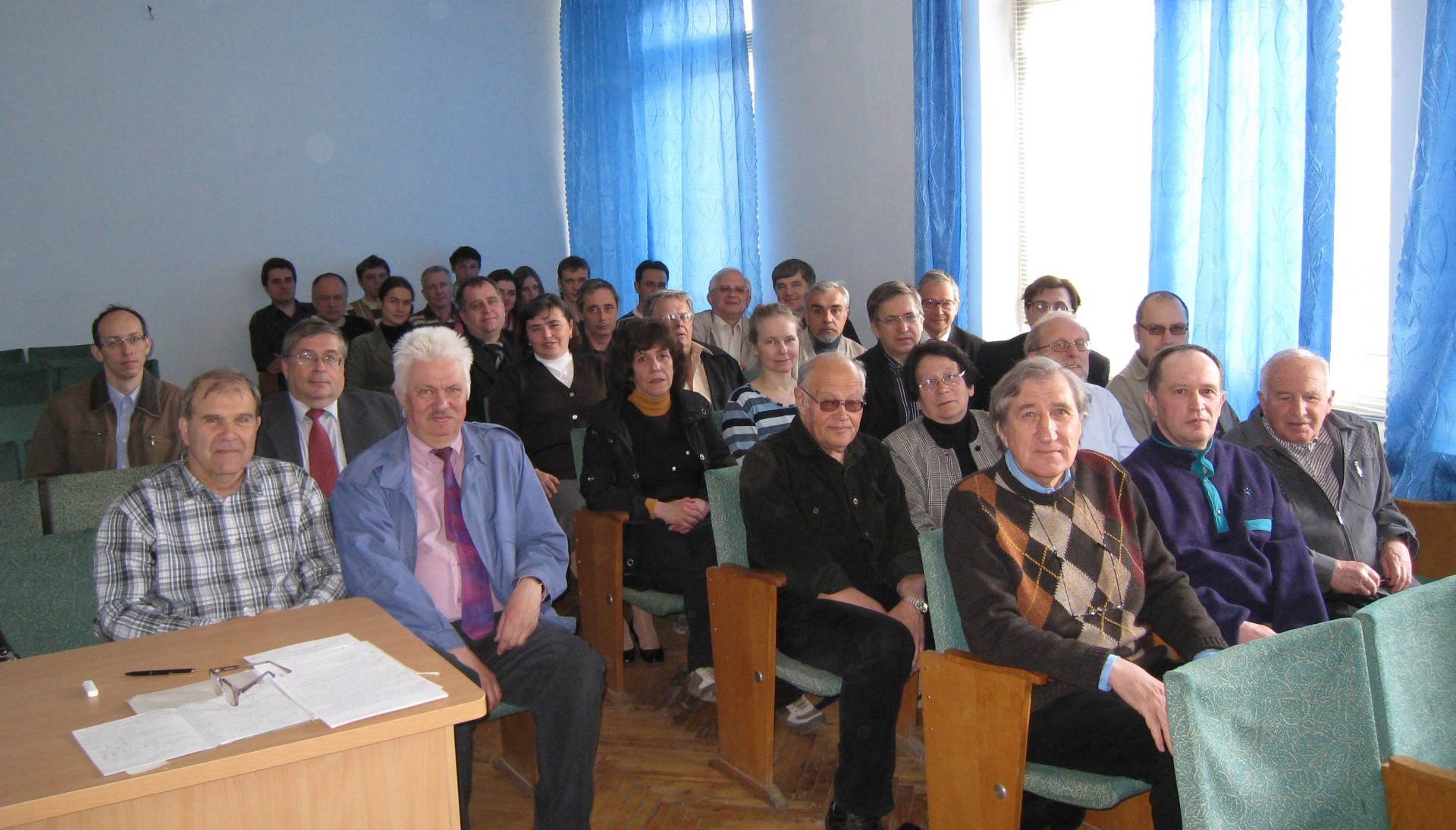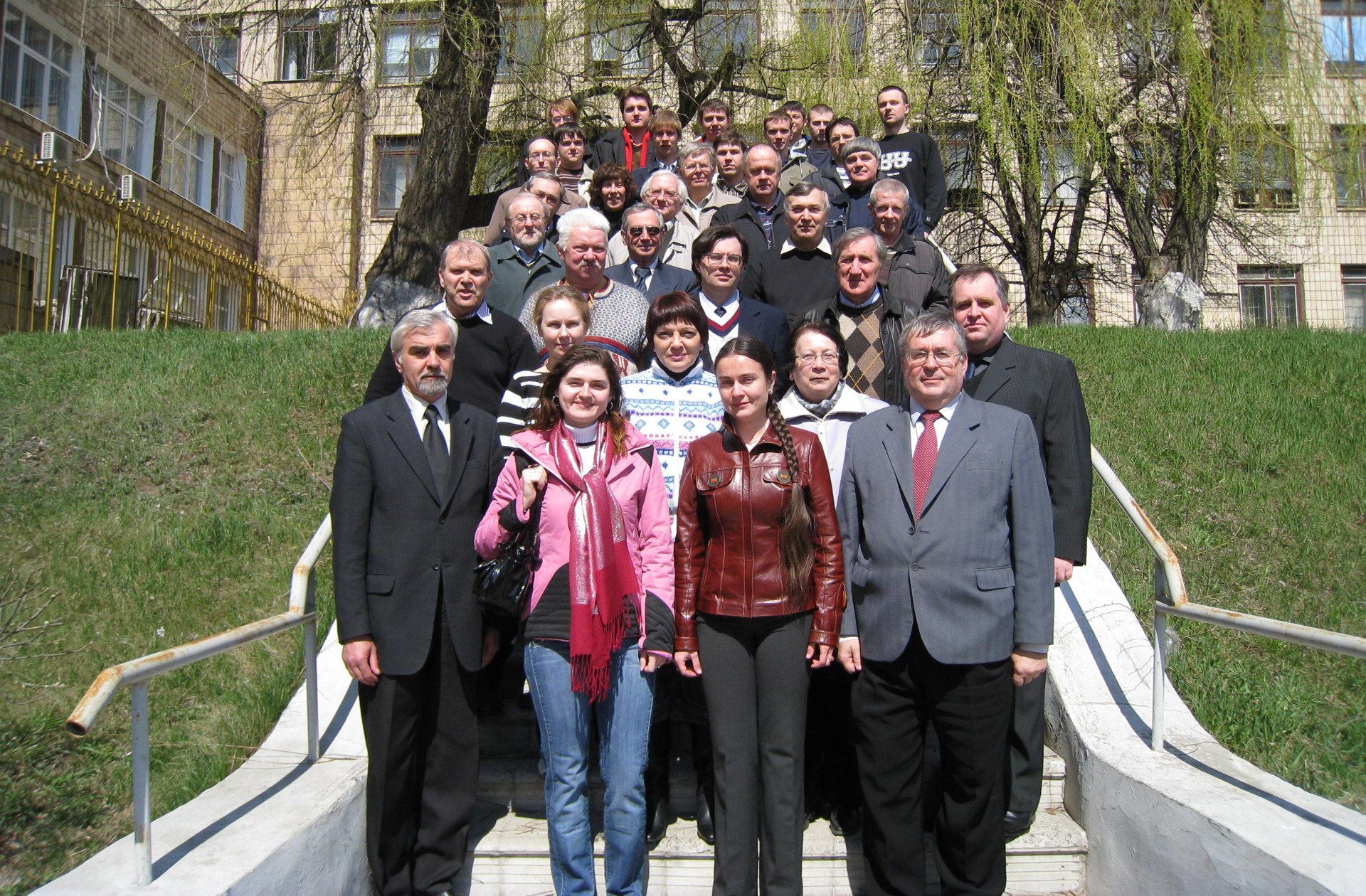The Department was organized in 2003 as the result of merging the Department of "Theory of Electronic Properties of Solids" (headed by Professor R.N. Gurzhi ) and the Department of "Quantum Theory and Nonlinear Dynamics of Macroscopic Systems" (headed by Professor A.M. Kosevich ).
The first head of the Department was Academician of NAS of Ukraine L.A. Pastur.
From 2016 up to 2021 the head of the Department was Professor I.V. Krive.
Since 2021 the Department is headed by Doctor of Sciences V.V. Slavin.
At present the Department includes 25 members with 11 Doctors of Sciences (DS) and 12 Candidates of Sciences (Ph.D.) among them.

Employees of the Department of Theoretical Physics

ILT, Employees of the Department # 26
Main areas of research:
- Solid State Physics
- Quantum liquids, quantum crystals and cryocrystals
- Nanophysics and nanotechnology
- Spectral theory of random operators and large random matrices in condensed matter physics
- Electronic properties in conducting and non-conducting systems
- Physics of magnetic phenomena, spintronics
- Computer modeling of physical properties and processes in condensed medium
- Quantum macroscopic phenomena
- Low-dimensional physics
- Physics of surface
- Physics of multilayer structures, metamaterials
- Disordered quantum systems
The most important results:
- Novel phenomena in physics, such as Majorana fermions in condensed matter, were studied. It was shown that the presence of unbiased electrode restores zero-bias anomaly even for strong Majorana energy splitting. It was also shown that strong asymmetry provides one with the criteria to distinguish Majorana state from ordinary (impurity) resonance state.
- A theory of a thermally induced single-electron "shuttling" instability in a magnetic nano-mechanical device subject to an external magnetic field is presented in the Coulomb blockade regime of electron transport.
- It was shown that a nanoelectromechanical system can be mechanically actuated by a heat flow through it via an electron-electron interaction (nanoelectromechanical heat engine). In contrast to most known actuation mechanisms in similar systems, this new mechanism does not involve an electronic current nor external AC fields.
- The ground state structure of two-dimensional lattice systems with a long-range interparticle repulsion has been studied. Electron's stripe formation and effective lowering of the system dimension have been discovered.
- Absence of the self-averaging property of the entanglement entropy of disordered free fermions in one-dimension has been discovered.
- Novel inter-subband mechanism of microwave-induced conductivity oscillations and absolute negative conductivity in multisubband 2D electron systems.
- Anomalous quasiparticle reflection from the surface of a 3He-4He dilute solution.
- Nonlinear dynamics of a 2D Wigner solid on superfluid helium.
- A theory of kinetic phenomena in two-dimensional degenerated electron gas in heterostructures has been built. It has been shown that dynamics electron-electron scattering in such systems acts in a completely different way as compared to the three-dimensional metals. New kinetic effects were predicted, viz. (i) one-dimensional diffusion of charge carriers as a mechanism of charge transport in two-dimensional systems; (ii) the ultra-sensitivity to weak magnetic field of relaxation mechanisms, related to the two-dimensional electron-electron scattering at low temperatures, was predicted. Recently, both these effects and the typical hydrodynamic minimum of the electric resistance of two-dimensional high-mobility GaAs/AlGaAS channels have been observed experimentally by the group of Prof. L.W.Molenkamp (Wurzburg, Germany).
- A theory of propagation of electron beams in a two-dimensional degenerated electron gas was built. The theory was used to propose and develop a scattering spectroscopy method made it possible to find experimentally the specific two-dimensional features of the electron-electron scattering predicted by the group members earlier. The nonlinear effect of the heating of electron beams in a two dimensional electron gas was predicted and observed experimentally later.
- A "spin-guide" source was proposed. This device makes possible a long-distance transmission of currents with a high degree of spin polarization. Under certain conditions a spin-guide could generate an almost ideally spin-polarized current, even when the magnetic material used is not fully polarized. The detailed theory of the spin-guide structures was developed and a number of schemes of spin field-effect transistor both with electrical and magnetic control were proposed and investigated theoretically. The role of electron-electron collisions in the charge and momentum transport in hybrid magnetic/nonmagnetic structures was discussed.
- A theory of the injection of super narrow beams into solid state structures through the micro- and nano-constrictions of arbitrary shape was developed.
- A scheme of a transistor device which may amplify and generate an a.c. spin signal has been proposed. This device exploits the spatial separation of the spin components of the current and the electric gates in a special hybrid magnetic-nonmagnetic structure. The construction of such a device should be feasible with current materials and fabrication techniques.
- An effect of the "spin pendulum" in a ring-shape of spin-valve geometry has been predicted -- the time oscillations of the total current and the spin polarization in an inhomogeneous magnetic conductor at presence of the hydrodynamic transport of electrons. The effect may have important applications in nano-electonic curcuits.
- Exact description of dynamics of discrete breathers and nonlinear periodic waves in integrable models of anharmonic crystals and nonlinear transmission lines.
- Exact solutions of spectral problem for localized excitations and scattering problem for spin waves in anisotropic magnets containing domain walls and spin clusters in the presence of a magnetic field.
- Construction of the theory of the local negative magnetic permeability in low-dimensional nonlinear metamaterials containing breather excitations.
- For the first time, a physical explanation for the experimental observation of the negative thermal expansion of the textured carbon nanotubes observed at low temperatures was given. It is shown that this effect is caused by the rapid growth of the torsional oscillation amplitudes of individual nanotubes in the bundle with increasing temperature. A theory was developed that describes the negative effect of one-dimensional character of the behavior of spectral densities of states of such oscillations.
- The theory of the electron magnetic susceptibility of topological semimetals.
- The theory of the electron topological transitions of 3½ kind in metals and nodal-line semimetals.
- The theory of spontaneous symmetry breaking of magnetostriction in metals with multi-valley band structure.
